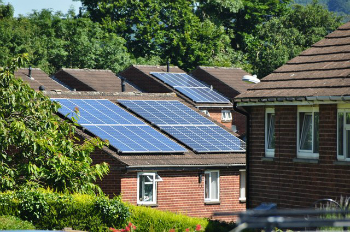Distributed Energy

Distributed energy hopes to decentralize electricity production to privilege and take full advantage of the potential for renewable sources like wind and solar.
General Overview
Traditional electricity generation happens in large, centralized power plants, which produce power that is then transmitted throughout the electric grid. With fossil fuel based power generation, this made sense, because of the increased efficiency gained with economies of scale, and the large transport costs associated with fossil fuels (coal, natural gas, etc.).
This type of generation and distribution is not without its problems though. Electricity is lost when transported over large distances, meaning that it is expensive to serve far-flung rural areas from power plants built to provide power to more densely populated urban centers. And because of the low density of rural areas, it may not be economically efficient to construct power plants closer to rural end-users.
Distributed energy (often termed DER, or distributed energy resource), is smaller-scale power generation that takes places close to the location of consumers. While DER can include certain fossil fuels, like waste-to-energy, or smaller gas generators, today it is most widely talked about in the context of renewables. Specifically, distributed commercial and residential solar photovoltaic.
Renewable technologies—wind turbines, thermal energy, energy storage, and in particular, solar— are a natural fit to be DERs because they require no transport cost for fuels. In addition, by locating the generation of energy closer to consumption, renewable DER can help increase efficiency through lower energy loss in transmission.
So what’s necessary to help distributed energy take off? Often, it boils down to two words: net metering.
Net metering essentially allows your electric meter to run backwards—subtracting the excess energy that you produce and send out to the grid from the energy that you consume.
Because of an inability to store energy for consumption later, residential solar producers still need to purchase electricity during the times of day when their demand exceeds what their rooftop solar panels are producing. As such, this process of net metering is what makes residential solar economically viable for most customers, giving them an incentive to install panels by allowing them to save, or even make money, every month.
Did you know? The states with the most favorable net-metering regimes are Arizona, California, Colorado, Connecticut, Delaware, Maryland, Massachusetts, New Hampshire, New Jersey, New York, Ohio, Oregon, Pennsylvania, Utah, Vermont, and West Virginia.
Typical DER systems also use feed-in tariffs. A feed-in tariff is essentially a price guarantee. Put to effective use in the United States, Spain, Denmark, and in particular, Germany, feed-in tariffs guarantee purchase of renewable energy according to its cost of production, usually over a period of fifteen to twenty-five years. The argument for feed-in tariffs is that guaranteeing a certain level of profitability to renewable energy incentivizes its production, and ultimately making it more economically competitive through greater research and development, and economies of scale.
Distributed energy has large potential to be combined with demand response and smart grids to form the electricity production and distribution systems that will be our new normal in the next few decades.
Did you also know? The price per watt of producing solar energy has fallen by 99.6% since 1977, to roughly $0.40 per watt today and is projected to fall another 40% in the next few years.
As rooftop solar continues to advance in both residential and commercial domains, propelled by companies like SolarCity, more and more states are moving forward with either net-metering programs or similar ones, like Texas.
Types of DER
Cogeneration - cogeneration plants use steam to turn generation turbines, and then use the exhaust heat either for space or water heating.
Solar - solar PV is the biggest player in the current DER arena. Residential and commercial rooftop solar have huge potential, and net metering and companies like SolarCity are beginning to turn this more and more into reality.
Wind - largely complements solar.
Hydro - wave power is another potential player as a distributed energy resource.
Waste-to-energy - more common in Europe than in the United States, waste-to-energy plants incinerate trash to produce electricity. New York City has spent the better part of three decades debating a waste-to-energy plant as a solution to its colossal garbage disposal problems.
Storage (vehicle-to-grid, battery, molten salt) - distributed energy could be stored and then fed back into the grid at times of peak demand.